I will give a technique for teaching children how to tell time using a clock. One of my good friends was impressed by the courses and suddenly volunteered to do a course on this topic) Accordingly, the methodology and course Determining time by clock are his authorship.
This was the first experience when a course on the service was taught not by me, but by another person. Overall the experience was a success, it turned out great.
My previous techniques
General scheme
Determining the time using a digital clock is simple - just read the two digits corresponding to the hours and minutes.
Determining time using an analogue clock – more difficult task, which we will now analyze.
Details for each block
Step 0. Repeating addition
To successfully complete the course, you need to be able to add numbers within 100 (to calculate minutes and convert time from a 12-hour format to a regular one). Also, it is advisable to be able to multiply by 5 - this will also help calculate minutes faster.
Step 1. Concepts of day, midnight and noon
Knowing this will help you navigate time and prepare you for translation 12<-> 24.
Step 2. Concepts of dial, hour hand, minute hand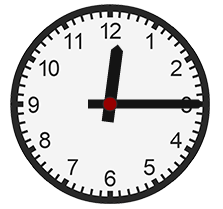
Step 3. Determining the hour in 12-hour format
Step 4. We count the marks on the dial and the spaces between them
We analyze a minute (small interval), 5 minutes (large interval). 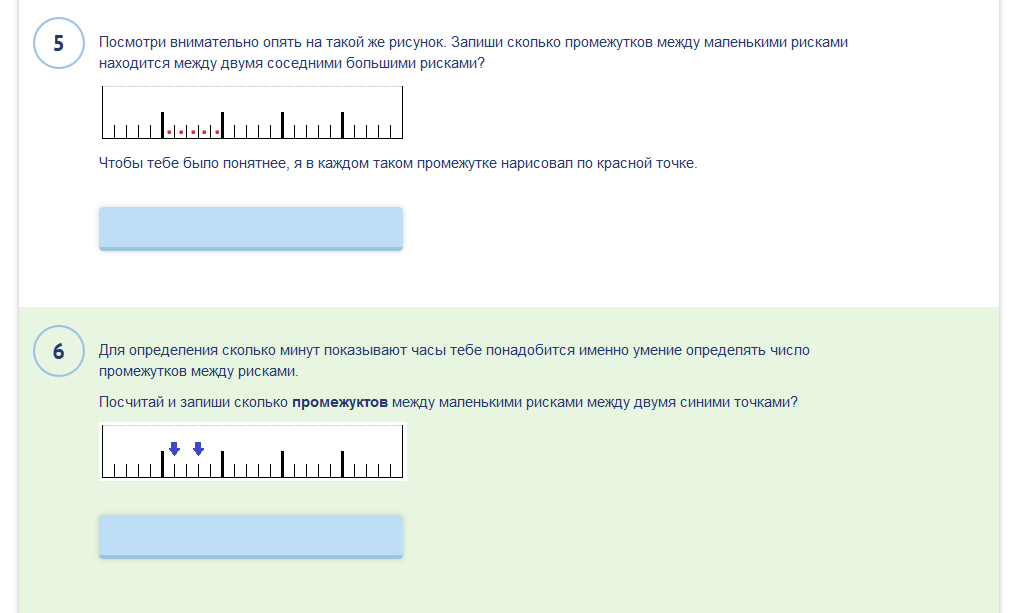
Step 5. Determining the minutes
Based on the already acquired skill of counting risks and multiplying by 5. 
Step 6. Then you can determine the time in 12-hour format
Based on the ability to determine the hour in a 12-hour format and the ability to determine minutes, this is done simply. 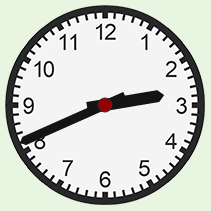
Step 7 Finally, we determine the time in 24-hour format
Using the understanding of the day, midnight (the beginning of the day) and noon (the middle of the day), we study the division of the day into two clockwise circles. We acquire the skill of telling time in 24
What you need to know to get started
count within 100
addition by passing ten
The course operates in the same logic
skills are acquired gradually
you can learn independently (for many children this increases self-confidence)
the simplest skills are transferred to the “automatic” level
In conclusion
I would like to say a big thank you to Dmitry for the methodology and course. I am sure that it will be useful to many.
P.S. For this course, I specially made a widget that made it possible to conveniently draw an analog clock, insert it into tasks and create tasks with a drawing (of a clock) automatically. It seems like nothing happened)
Adults often don't think about skills like telling time with a clock because they take it for granted. But for children this concept remains a mystery, since for them time is an abstract concept that cannot be touched or seen. Therefore, you need to be patient and attentive.
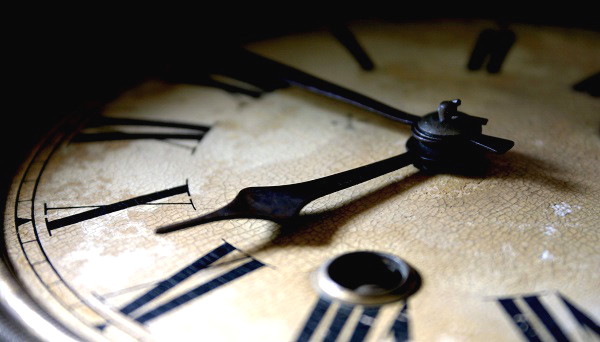
The main emphasis during training you need to place on systematicity and consistency. Start with something simple - tell your baby in detail about the time, show the clock, tell what the hands are for. You can find suitable rhymes, funny songs or riddles that will help develop understanding among the little ones. Explain to your child that a day consists of twenty-four hours. You can focus on the usual actions that you perform with your baby every day. For example, we brush our teeth at 7 am, and go to kindergarten at 8, have dinner at 7 pm, and go to bed at 9. In order to reinforce the material, accompany each action with a reminder of the time, and also show your baby the dial.
An important part of learning is the child’s ability to count. If you teach your baby to count to 12, it will be easier for her to understand the dial. In order to explain such a concept as seconds, you need to be able to count to 60. Before starting classes, make sure that your baby knows how to count well.
Don't forget that telling time is an important social skill. Thus, the baby will be able to learn to navigate in space, form an understanding of what things need to be done and at what time of day. But in order for the baby to better assimilate valuable information, think about the method of presentation. It should be interesting and understandable to kids. It is best to accompany the story with colorful illustrations. Toy stores sell funny watch faces with rotating hands. You can turn them into teaching material.
Along with this they search and read:
Video: Learning time in a fun way
Learning through play

As already mentioned, the material is best absorbed in game form. You can find online games, which will be the best help. Such games include those where a dial is displayed on the screen, and the time that needs to be “set” is indicated next to it. Children need to place the arrows correctly, based on their knowledge. If everything was done correctly, a green window will light up below, in which praise will be written. Otherwise, the window will turn red and “error” will be written on it.
The following game is rightfully considered the most effective. Take a toy dial (you can cut it out of thick cardboard and stick on the arrows, just make sure they rotate), give the dial to your baby and talk about the daily routine. Each action must be accompanied by the movement of arrows. Show him what time mom cooks dinner or when you go for a walk. Such a game will strengthen the baby’s orientation in space - after that he will be able to look at the dial and know after what time to go to bed or go to eat.

Another simple game is to ask the little smart guy to set the arrows to this or that time, and also to set the minutes yourself and ask the little one to name what time it is. At first, try in every possible way to focus the child’s attention on what is being studied - watch cartoons, talk, pay attention to the alarm clock. In order to consolidate the result, ask what the hands on the dial show more often. The most important thing is do not force the baby to memorize, let learning be a joy for him.
The problem of how to teach a child to tell time using a clock is more difficult than it seems. The hour hand marks periods of time, numbered from one to twelve, and the minute hand, moving along the same dial, measures time, divided into segments from one to sixty! Children often find it difficult to understand the combination of these two systems. But there are always ways to help them.
What we need to know before training
Please note a few points before starting training:
- Make sure your child can count to sixty - otherwise he will simply not be able to count the minutes. Without this skill, learning watchmaking wisdom will be meaningless.
- Memorize the multiplication table for “2”. Knowing that five four equals twenty, the baby will be able to correctly interpret the readings of the minute hand.
Method one: Big clock
Buy large chronometer with clearly visible large arrows. It is best to remove the glass from it and make sure that the hands are easy to move by hand. 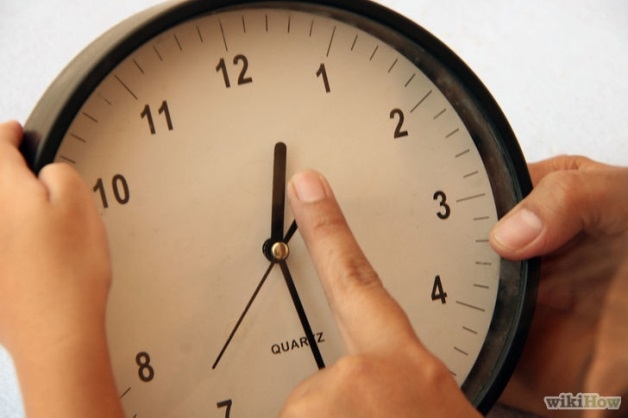 Explain to your child that the short hand shows the clock. Move it around the dial - whichever number it looks at, that’s the time it is. Let your child try moving the pointer himself until he learns how to unmistakably tell time to the nearest hour.
Explain to your child that the short hand shows the clock. Move it around the dial - whichever number it looks at, that’s the time it is. Let your child try moving the pointer himself until he learns how to unmistakably tell time to the nearest hour. 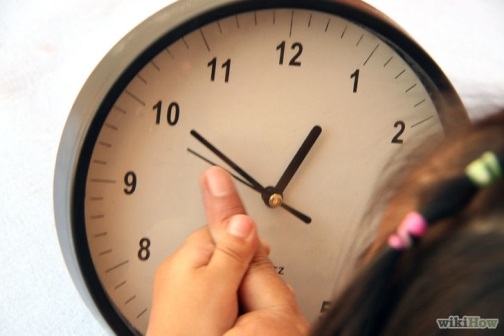 Explain that the long hand shows the minutes. Circle around the entire dial and explain how many minutes are in an hour in each position. Start with numbers that are multiples of five, when the baby understands the principle, move on to the twelfth, thirty-seventh and similar minutes. Pass the initiative into the hands of a child, let him practice until he reaches automaticity in the new skill.
Explain that the long hand shows the minutes. Circle around the entire dial and explain how many minutes are in an hour in each position. Start with numbers that are multiples of five, when the baby understands the principle, move on to the twelfth, thirty-seventh and similar minutes. Pass the initiative into the hands of a child, let him practice until he reaches automaticity in the new skill. 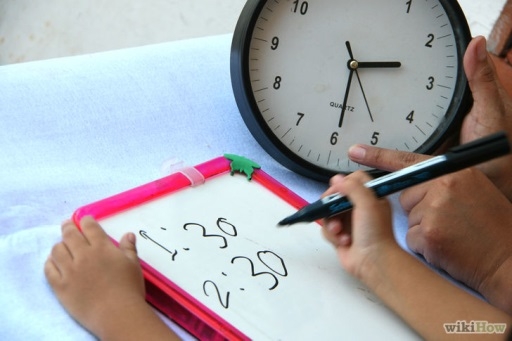 Let's combine all the concepts together. Start with simple values(for example, 1:30, 4:45, 8:05) and move on to complex ones - 2:37, 12:59. At the end, ask your baby to tell the time using arrows that cover each other (for example, 1:05).
Let's combine all the concepts together. Start with simple values(for example, 1:30, 4:45, 8:05) and move on to complex ones - 2:37, 12:59. At the end, ask your baby to tell the time using arrows that cover each other (for example, 1:05). 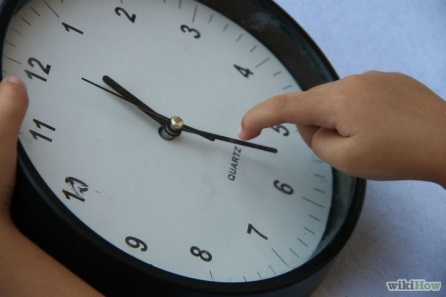 Play the quiz in reverse. The kid makes a wish for the time, puts it on the dial, and you say what time it is. Sometimes make mistakes on purpose - let a careful student correct you. This will give your child confidence and maintain a sense of control over the situation.
Play the quiz in reverse. The kid makes a wish for the time, puts it on the dial, and you say what time it is. Sometimes make mistakes on purpose - let a careful student correct you. This will give your child confidence and maintain a sense of control over the situation. 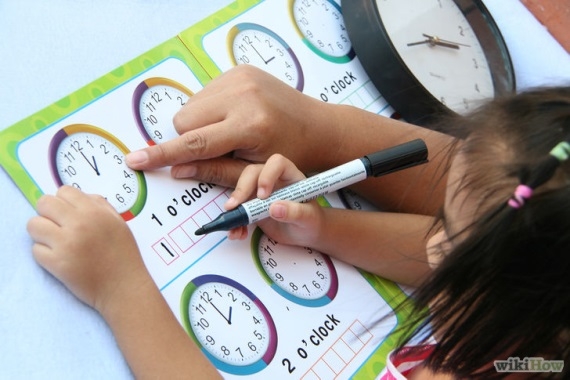 And again the quiz- but now you are acting as the leader. Don't forget: praise and recognition are components of success.
And again the quiz- but now you are acting as the leader. Don't forget: praise and recognition are components of success.
Method two: Paper
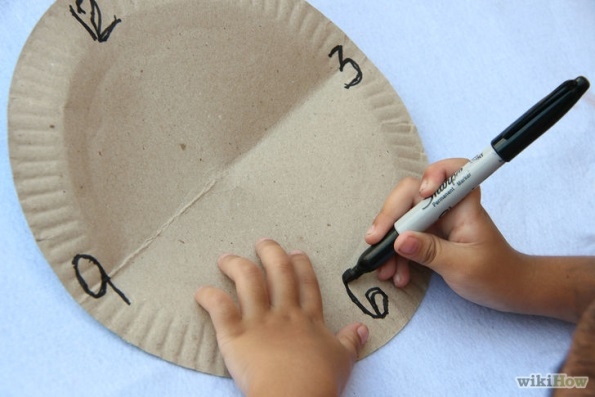 Together with your child, draw a large circle on a piece of thick paper and cut out a clock from it. (You can also use a large paper plate). Fold the circle into four parts, label them with numbers 12, 3, 6 and 9.
Together with your child, draw a large circle on a piece of thick paper and cut out a clock from it. (You can also use a large paper plate). Fold the circle into four parts, label them with numbers 12, 3, 6 and 9. 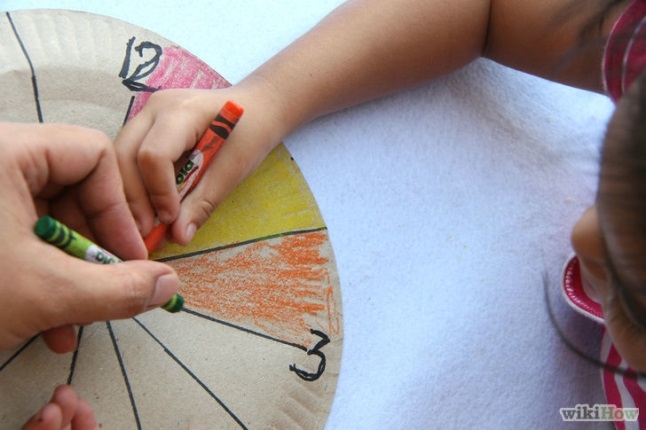 Decorating the “time pie”. We divide the dial into sectors of one hour and paint each of them in a separate color. It is best to follow the colors of the rainbow, but this is not necessary.
Decorating the “time pie”. We divide the dial into sectors of one hour and paint each of them in a separate color. It is best to follow the colors of the rainbow, but this is not necessary. 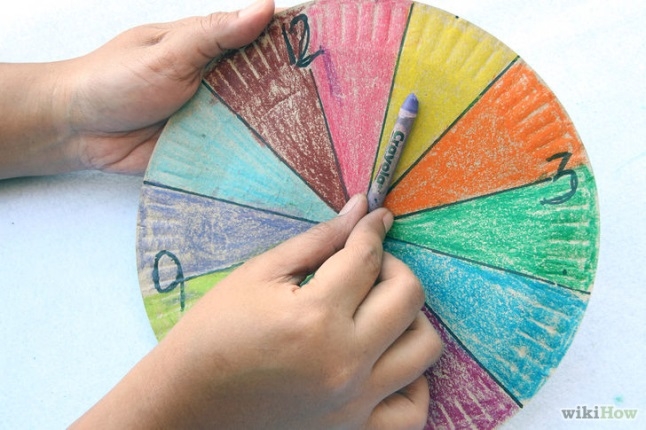 Using wax pencils we explain how the short arrow works. What sector is she in? This is the time now.
Using wax pencils we explain how the short arrow works. What sector is she in? This is the time now. 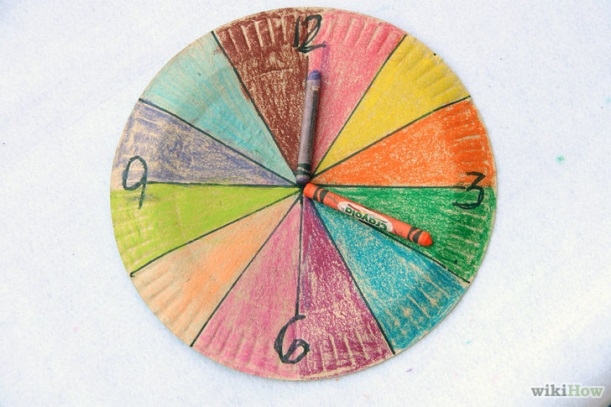 Drawing a new circle, marking it with minute marks. This dial should not be painted - you will need too many colors and the sectors will turn out very narrow.
Drawing a new circle, marking it with minute marks. This dial should not be painted - you will need too many colors and the sectors will turn out very narrow. 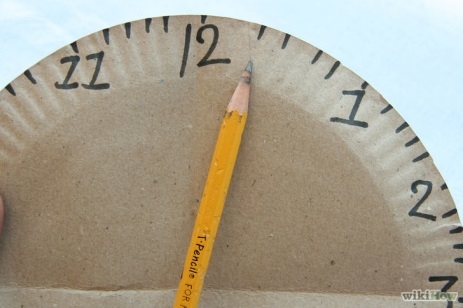 Using a pencil, explain how the minute indicator works.
Using a pencil, explain how the minute indicator works. 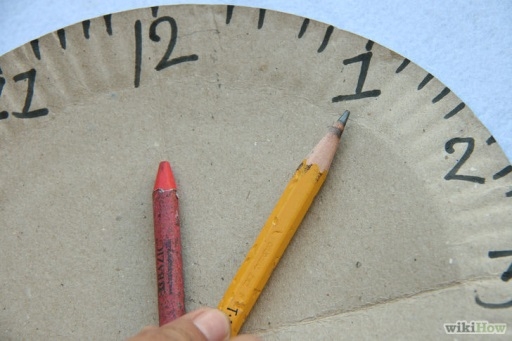 We combine wax and simple pencils and write down their readings on paper.
We combine wax and simple pencils and write down their readings on paper. 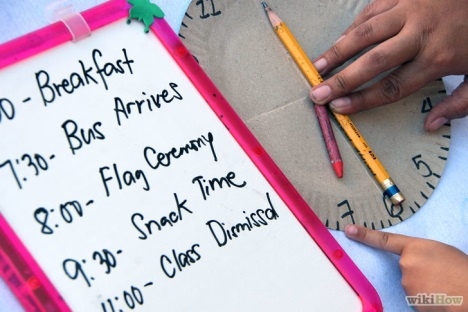 Making a daily schedule– what time does the baby get up, what time does he go to kindergarten or school. We write down the schedule on a piece of paper, and let your young watchmaker show all these points on the chronometer.
Making a daily schedule– what time does the baby get up, what time does he go to kindergarten or school. We write down the schedule on a piece of paper, and let your young watchmaker show all these points on the chronometer. 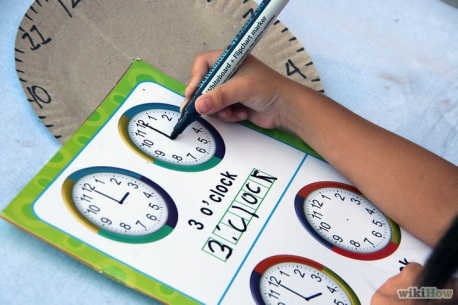 Take a TV program and ask your child to indicate the start time of his favorite programs.
Take a TV program and ask your child to indicate the start time of his favorite programs.
Method three: Large chronometer and schedule
The techniques for teaching a child to tell time using a clock are truly endless. Here's another one - it can be used in addition to the two already described. 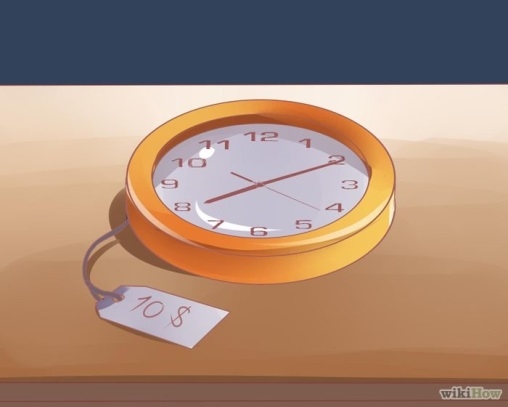 Hanging a new one in the kitchen big chronometer. Don't forget to put good batteries or high-capacity batteries in it. It is best to mount the device on a dowel - and, most likely, you will not be able to do without a drill and hammer.
Hanging a new one in the kitchen big chronometer. Don't forget to put good batteries or high-capacity batteries in it. It is best to mount the device on a dowel - and, most likely, you will not be able to do without a drill and hammer. 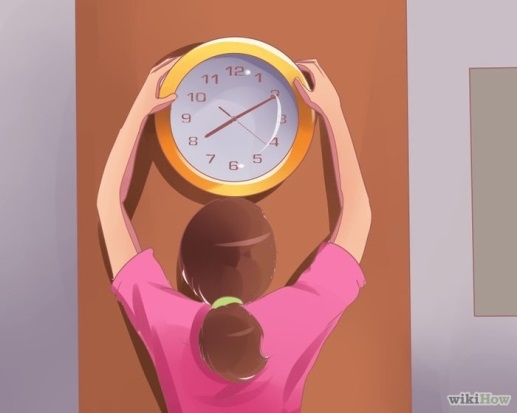 We show the child where the main chronometer of the family is located.
We show the child where the main chronometer of the family is located.  We hang it under the chronometer family life schedule. What time do we usually get up, what time do we go to bed, when does someone leave the house and when does someone come.
We hang it under the chronometer family life schedule. What time do we usually get up, what time do we go to bed, when does someone leave the house and when does someone come. 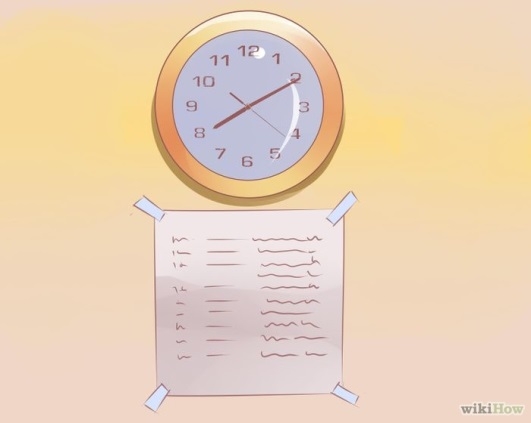 Checking out the real life of the family with a schedule. Are we awake? Let's go see what time it is. Is it earlier or later than usual? For how many minutes? When did daddy come home from work? How long did he stay? Why?
Checking out the real life of the family with a schedule. Are we awake? Let's go see what time it is. Is it earlier or later than usual? For how many minutes? When did daddy come home from work? How long did he stay? Why?  Children usually like this kind of fun (although not all adults are delighted with it). The main advantage of the schedule and chronometer is the huge amount of practice. Having worked closely with the clock and schedule, the baby will remember for the rest of his life what and how the arrows tell us.
Children usually like this kind of fun (although not all adults are delighted with it). The main advantage of the schedule and chronometer is the huge amount of practice. Having worked closely with the clock and schedule, the baby will remember for the rest of his life what and how the arrows tell us.
Finally, let us remember the wonderful story of Fazil Iskander, where “a lively and chatty boy” (as he called himself) Chick sharply dimmed when he had to find out what time it was. He was already big, but he never learned this skill, and it was a shame to admit this inability. So Chick suffered until he went to the station, stood in the thick of the people, and listened all evening long to the details of the train schedule. He listened to the dispatcher's words about departing and arriving trains, while looking at the city's main clock. Gradually, the abundance of what he heard turned into knowledge, thanks to which he was able to prove to his friends that he was no worse than them.
Let's get the moral out of the story: do not put pressure on children, do not say taunts to them, do not enjoy the fact that you can do something better than them. This will not solve children's problems, but, on the contrary, will force them to look for a way out, often ineffective and time-consuming.
Your main task- be an advisor and mentor. If you do it with love and faith in success, then you are an excellent parent. For today, start small - choose a way to teach your child to tell time using a clock.
Time is a strange concept that has an abstract nature: it cannot be seen or touched. But every child should learn to tell time, understand clocks and use them. Without learning to do this on time, it will be difficult for the child to adhere to the daily routine and plan his time when he goes to school. The ability to tell time is an important and necessary component of a child’s development. From our article you will learn how to teach this to your baby.
Learning the clock
Understanding time is not an easy skill. When the newborn grows up and begins to sense the passage of time, for example, eat at the same time, recognize where it is day and where it is night. A strengthened baby will soon master the concepts of “morning”, “day”, “evening” and “night”, and a little later he will learn to recognize the seasons, months, and days of the week. All of these categories are very necessary to begin to understand watches. After all, a watch is a means by which a child will be able to navigate time and correctly determine it. Where should parents start to introduce their baby to watches at home?
Forming preparatory skills
So, in order to start an easy, unobtrusive and interesting training for your child to understand the clock, you need to figure out what skills he has already developed. If you find out that the child has not yet mastered all the necessary skills, then you need to focus on ensuring that he acquires them before starting active learning to tell time.
The child must:
- from 1 to 12
- recognize numbers 1 -12
- count in order from 1 to 12
- recognize the hour and minute hands
- show direction of arrow movement
- count to 30
- Count up to 30 with “fives” - 5, 10, 15.
“If you start teaching a child to understand the clock while simultaneously teaching him to count from 1 to 12, you will not cope with the task.”
Let's start learning the clock
- Step one. At the beginning of training, you can take a large watch (preferably a round one, without unnecessary decorative elements, or a children's or toy watch). You can use a clock mockup by making it from cardboard or a paper plate. The numbers on the clock should be large and clearly depicted - for now only hours, no minutes. The arrows should rotate easily. At first you only need the hour hand.
It’s easy to make a mock-up of a teaching clock yourself
- Step two. Show and tell us what a “dial” is.
- Step three. Tell your child that the hand points to the clock, and therefore has the name “clockwise”. Demonstrate which direction it is moving and explain that this movement is called “clockwise”. Invite your child to consolidate the knowledge gained by turning the arrow in the right direction. Explain that the hour hand counts down the hours.
- Step four. Practice with your child to reinforce the concept of “exactly one hour.” To do this, you need to set the hour hand to any number, voice the value (for example, “exactly two hours”), and then try to set it for different times. Teach your child to move the hour hand along the numbers and tell the time: “One hour, two...” and so on. Tell and show your child what the concept of “an hour ago” means.
"Advice. The best thing you can do to get your child interested in learning to understand a clock is to make one together with your child. In the process of joint creativity, the baby will understand what certain elements of the watch are intended for.”
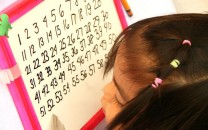
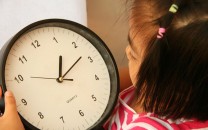
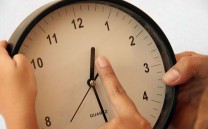
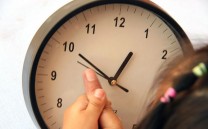
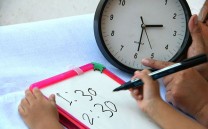
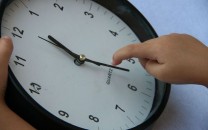
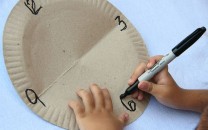
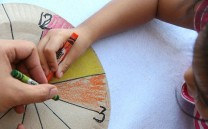
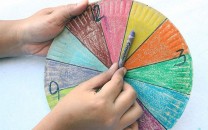
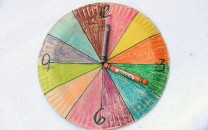
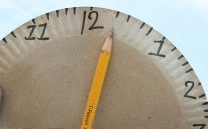
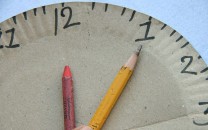
Let's navigate in time
In order to make it easier and more enjoyable for a child to acquire the ability to easily navigate time, parents need to show its value. For example, you can get interested in time by connecting it with important events for the child: a walk, going to a puppet theater or circus, watching an evening fairy tale on TV. Emphasize that you need to know the time so as not to be late and not miss anything interesting.
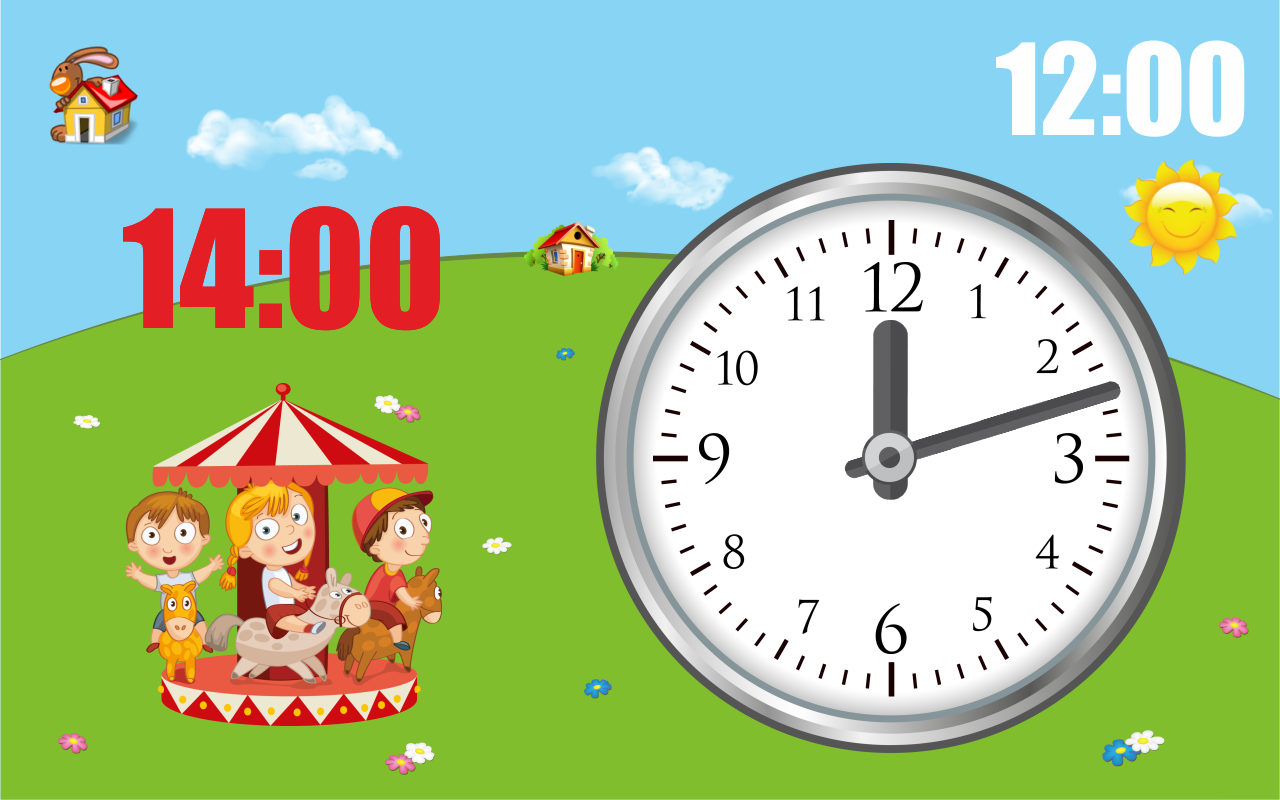
A colorful poster will help your child realize the value of understanding time.
How easy is it to convey this to a child?
You can draw a colorful poster on which important events for the baby will be marked on the watch: what time is it for a walk, what time is it for a visit, what time does your favorite TV show start. Provide the poster not only with large images of a clock and the time on it, but also with colorful pictures symbolizing certain events. The same poster can be made to remember the child’s daily routine. The baby, looking at the hint poster, will learn not only not to be late for anything and do everything on time, but will also begin to navigate in time. Seeing that the baby understands, then it will be possible to change events and time: this way, without really straining, he will master and consolidate the basic skills of time orientation. And then you can safely move on to studying the minutes.
Determining time using clocks and hands
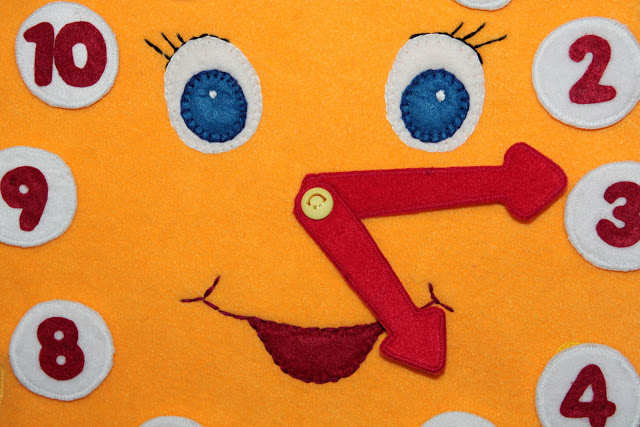
Having introduced the hour hand, we begin to study the minute hand.
If the baby has already understood what the hour hand shows, then you can get acquainted with the minute hand:
- Add a minute hand to your classroom clock or mockup.
- Tell us that the minute hand is thinner and longer than the hour hand. Let your child practice and memorize the differences between the two arrows.
- Explain to your child that in one hour the minute hand travels the entire circle.
- Show that if the hour hand clearly shows one hour (two, three, four...), then the minute hand is always up at 12. Practice reinforcing this concept.
- When starting to study half an hour, show where the hand is located on the dial in the case when only half an hour has passed. Let your child place the minute hand at half an hour (at the number 6) and practice telling the time.
- Next, you can move on to studying the position of the minute hand when 5, 10, 15 minutes have passed, etc. Here it is necessary that images of numbers showing minutes appear on the classroom clock or clock layout.
What is a day?
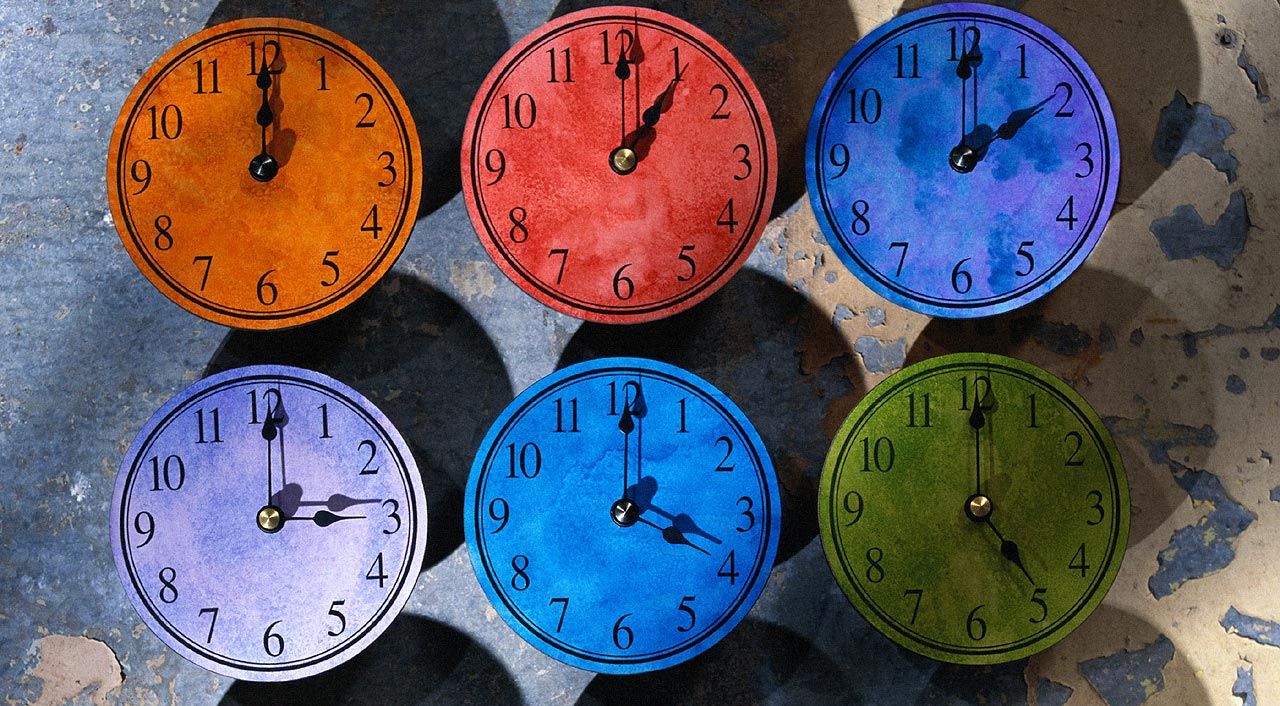
It is important for a child to learn to recognize different times of day.
Older child preschool age should be able to easily answer the question: “What time of day is it now?”
How to teach this?
- Use colorful (pictures) that clearly show what children usually do at one time or another.
- Train this skill in everyday communication with your child: “In the morning you wake up and have breakfast, in the afternoon you play, have lunch and sleep, in the evening you watch a fairy tale, have dinner and get ready for bed, and at night you sleep.” Encourage your child to make up their own options for what they usually do in the morning, afternoon, evening and night. List the time of day in forward and reverse order, randomly.
After the baby understands and distinguishes the time of day well, you can begin teach him the days of the week:
- Tell your child what a week is.
- Teach your child to answer the question “What day of the week is it today?”
- Explain to your child the order of the days of the week. There are many children's poems, songs and rhymes for this purpose.
- Practice remembering the days of the week using the terms “yesterday”, “today”, “tomorrow”. Ask your child more often: “What day of the week was yesterday?”, “What day will it be tomorrow?” Communicate daily about what happened yesterday and what we are going to do tomorrow.
Games with clocks
“There are a great many games for teaching a child to understand time: verbal, with pictures, computer games. All of them will be effective if they are selected in accordance with the child’s development level and his preferences.”
Watch an educational video that will help your child learn to understand the clock
We invite you to familiarize yourself with simple games that you can play with your child at home:
- “What time is it?” Take a school clock or a cardboard model of it, set it to some time, say seven. Ask your child to name where the hour hand is (short). Ask him what time it is? Help your child if he cannot answer right away, and then ask again.
- “What time is it 2?” Change the position of the clock hand and ask questions about what time it is. First, go to the right, clockwise, and then, when you see that the skill is being consolidated, change the position of the arrow in any order.
- "Make-believe." Tell your child that now you need to live through pretend play all day. Ask questions about what your baby will do at different times. Let him associate the morning, evening, day and night hours with typical activities for him.
- “Is it six now?” Ask your child a series of questions: “Is it six o’clock?” or “Is it eight now?” etc. The child must answer affirmatively or negatively. You can help your child with leading questions. This way he will learn to navigate in time.
"Advice. To ensure that exercises and games on understanding time do not tire the child and make him bored, try to introduce them into real life. Let’s say that a grown-up child can be instructed to keep track of time when getting ready somewhere: “Remind me that in 20 minutes we must leave the house so as not to be late for the show” or “Will you tell me when it’s three o’clock?” When cooking in the kitchen: “I let the pie sit for 30 minutes. Look at the clock and tell me when it will be ready?”

It's great to understand time and be able to use a watch
Dear parents, do not force your child to learn to understand by the hour until he himself shows interest. And for him to show interest, you need to help him: give him information to think about - show him funny thematic pictures or introduce him to funny poems. During training, try to connect tasks with real life. Let the child remind you what time it is, what time of day, etc. The best thing is when you manage to train your child. Then the baby will be interested, and he will quickly learn to understand the clock and use it. Remember that this skill is not acquired overnight, but is developed gradually. So be patient, consistent and then everything will work out.
Category: Pen stroke 09
Your little “why” has a million questions every day, and sooner or later he will begin to wonder “where the day goes” and “where the night comes from.” He understands what time is. This is a sign that you can soon begin to teach your baby to navigate the clock face. Let's figure out how to teach a child to tell time using a clock with hands. So that the little one can understand it, and mom and dad don’t need to drink valerian.
The principle of starting to learn to navigate time using a clock is the child’s ability to count to 100. Or at least to 60.
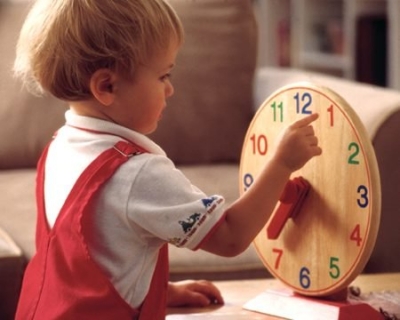
Thus, it is impossible to answer unequivocally the question of when to teach a toddler how to handle a watch. Some children can count well already at 4–5 years old, and some even at 6 may be confused in the order of numbers. But parents should not worry about this - such different age indicators are considered a variant of the norm, so humble yourself and be patient, because without knowing the rules of counting it is impossible to understand the mechanism of counting time. In addition, to understand the clock, the baby must:
- be able to visually distinguish numbers from 1 to 12;
- understand the principle of counting in 5-5, 10, 15, 20, etc.;
- write numbers from 1 to 12.
Is this all a passed stage for your child? Great, you can start mastering the concept of time.
Let's figure out what time is, from the point of view of a child's understanding of this concept. This is a certain number that mom and dad, as well as other adults, look at the clock and call.
The main task at the stage of familiarization with the intangible concept of time is to give the child a feel for intervals and the length of intervals using specific life examples.

- We explain the concept of “second”. Clap your hands so that one movement is equal to 1 second. This should be done in time with the clock with the second hand. And be sure to emphasize that now you are moving your palms in time.
- We turn time into duration. Say that one episode of the cartoon about Luntik lasts, for example, 10 minutes, and the baby spends 15 minutes getting dressed. Be sure to talk about how much time the little one spent on a particular game. This exercise will show your child what “fast” and “long” mean.
- We explain the concept of “day”. In fact, this is not so difficult to do; it is only important to consider the essence of the issue from the baby’s perspective. We can say that our day consists of 24 hours. Of these, half - 12 - the baby spends in the crib, resting, and the remaining 12 are distributed among food, activities, walks, games, etc. All these important things require different amounts of time, since some things are done quickly, and others - that's a long time.
So, the child already knows that time is determined by the clock, but has absolutely no idea how they work. To do this, you need to “make friends” with a watch, for example, by making a simulator. We recommend using a cardboard model of the dial.
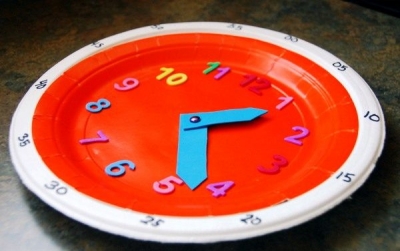
Instructions:
- Take a sheet of thick cardboard and cut a circle out of it. It is convenient if its diameter is 25–30 cm.
- A bright felt-tip pen (you can take felt-tip pens different colors) marking the hours.
- We cut out two hands (a larger minute hand, a smaller second hand) from pieces of cardboard of different colors.
- Use a nut to secure the minute and hour hands on the simulator.
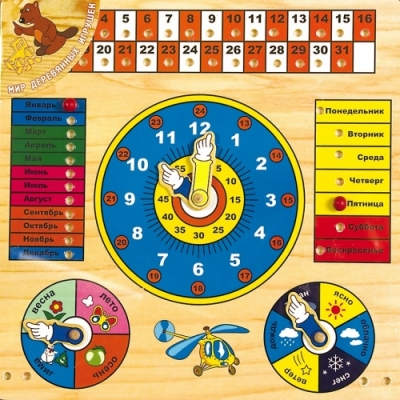
The sequence of explanations will be as follows:
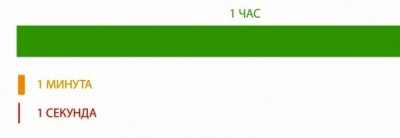
Exercises:
- Observation. Follow the circle that the second hand makes to understand the movement of the minute hand.
- Time tracking. Draw the baby's attention to the position of the minute and hour hands. Now indicate the period of time that you are timing (at least 2 minutes so that the movement of the minute hand is clearer). Let the baby mind his own business during this time, and after the measured period, look at the dial and tell him what he managed to do during this time. This way you will also clearly demonstrate to your little one the value of every minute.
The kid has already understood what a “whole hour” is; it’s time to move on to half and 15 minutes. To do this, you need to remind him that an hour is 60 minutes, which means that half an hour is 30 minutes. After this, it is worth drawing the child’s attention to the fact that the minute hand can point to half of this half - 15 minutes.
Exercises:
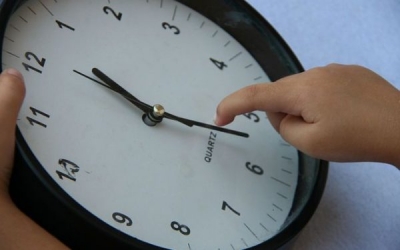
Smaller time intervals can begin to be explained to the baby only after careful assimilation of large time values.
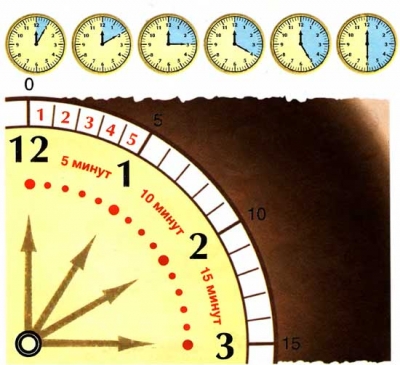
We start with 5 minutes. We explain to the child that a long arrow can move smaller. This is where the baby’s ability to “jump” over 5, which can be practiced on the simulator, comes in handy. To do this, it makes sense to put on the cardboard dial the values that will correspond to the minutes - opposite 1 we put 5, opposite 2-10, etc.
Exercises:
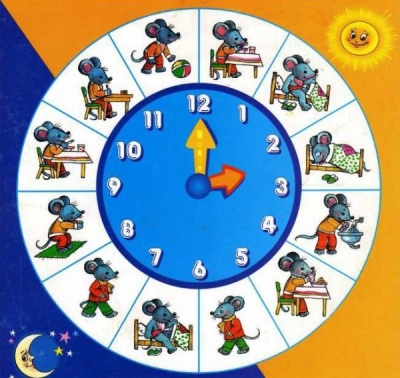
The game form of learning is the most effective when working with children. To master clocks with hands, there are a number of proven simple games:
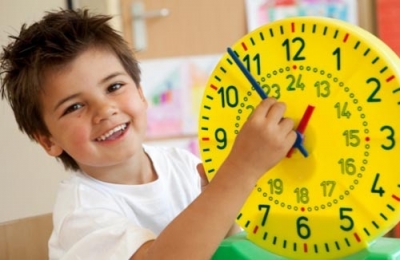
You can teach your child using video materials, but be sure to discuss what you saw with him and ask questions. Explain if the child does not understand something.
Children discover everything new and unknown with immediate joy. The task of parents is not to spoil such fertile soil with their impatience or indifference. So if your child is interested in how the clock runs (or you realized that your child is already ready to master the skill of handling a time measuring device), then arm yourself useful recommendations and start studying. And given the fact that children absorb new information at lightning speed, after just a couple of lessons the little one will have a watch on hand.



